3D 프린팅








광경화성 수지의 3D 프린팅은 최근 몇 년 동안 FFF에 이어 두 번째로 인기 있는 3D 프린팅 기술로 자리를 잡아가고 있습니다. , 전문가 및 제작자 환경 모두에서. 이러한 붐은 두 가지 중요한 요인의 결과였습니다. . 한편으로는 수지 3D 프린터의 저렴한 비용 새로운 기술의 출현으로 인해 레진 프린터는 FFF와 동일한 가격대에 놓였습니다. 한편, 신소재의 등장 치과용, 가요성 및 엔지니어링 레진과 같은 기술 덕분에 이전에는 FDM 또는 SLS를 통해서만 실행 가능했던 레진 부품을 생산할 수 있게 되었습니다.
치과나 보석류 등 일부 전문 분야에서 주목받고 있는 3D 레진 프린팅의 강점 , 고해상도 XY에서 50 µm ~ 150 µm 범위를 달성할 수 있습니다. 및 Z에서 30μm ~ 200μm 3D FFF 프린터의 최소 해상도보다 낮습니다. 결과적으로 레진 인쇄 부품은 높은 표면 품질과 높은 수준의 디테일을 갖습니다. 최고의 미적 품질 제공 적층 제조 기술의 모든 것
3D 수지 프린팅은 FFF나 SLS와 같은 대부분의 3D 프린팅 기술에서 사용되는 것과는 완전히 다른 원리를 기반으로 합니다. 여기에서 열가소성 폴리머가 시작점으로 사용되고 녹는 온도까지 가열되어 부품을 형성하는 반면, 수지 인쇄는 빛의 선택적인 적용에 의해 모노머와 올리고머의 반응성 혼합물을 중합하는 것을 기반으로 합니다. 즉, 플라스틱을 원료로 사용하지 않고 레진 프린팅에 플라스틱을 구성하는 기본 구성 요소를 사용하고 프린팅 과정에서 화학 반응에 의해 플라스틱이 형성된다는 의미입니다.
3D 프린팅용 수지는 주로 세 가지 구성 요소로 구성됩니다.
단량체 및 올리고머: 이들은 서로 반응하여 긴 중합체를 형성하는 작은 분자입니다. 플라스틱의 기본 구성 요소인 체인. 이러한 체인의 길이는 주로 속성을 결정합니다.
가교제: 크거나 작은 두 개 이상의 반응성 그룹을 가진 분자로 구성 다양한 지점에서 폴리머 사슬에 결합할 수 있습니다. 그 기능은 체인을 서로 단단히 연결하는 것입니다. 일반적으로 가교제가 있는 상태에서 형성된 플라스틱은 열경화성 플라스틱 또는 수지로 알려진 것을 생성합니다.
광개시제: 이것은 단량체 간의 반응을 촉진하는 역할을 합니다. 또는 이들 중 가교제와 함께. 이들은 일반적으로 염료 또는 형광단과 같은 유기 분자로, 주어진 파장의 빛이 있을 때 양이온 또는 자유 라디칼을 생성할 수 있으므로 라디칼 또는 양이온 중합 반응을 개시합니다.
일반적으로 파란색(405nm) 또는 보라색(365nm - 385nm)인 빛은 광개시제를 활성화하고 수지를 응고시키는 데 사용됩니다. 이는 가시광선 스펙트럼에서 가장 활발한 밴드이기 때문입니다. 이를 위해 조각의 일부가 될 영역만 각 레이어에서 조명됩니다.
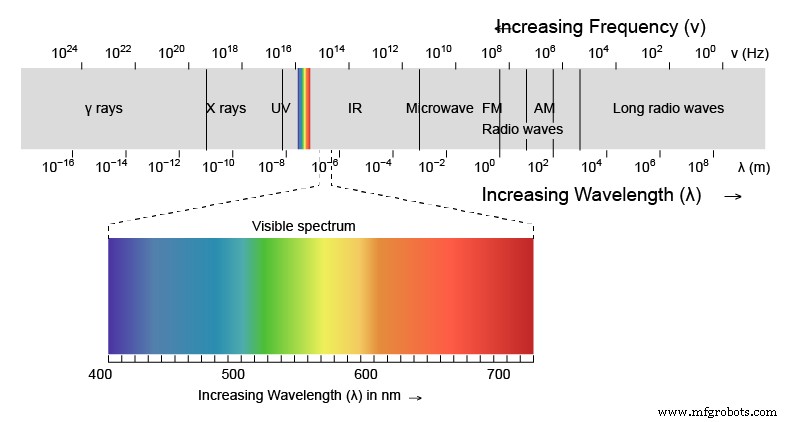
The 3D resin printing technologies are determined by the type of light source and the method of selective lighting used. Currently there are three common technologies:SLA, DLP and LED-LCD.
3D SLA or stereolithography printing is the oldest commercial 3D printing technology. It was developed during the first half of the 1980s and was patented in 1986 by 3D Systems founder Chuck Hull, just three years before Stratasys founder Scott Crump patented FDM technology.
In 3D SLA printing, the resin is cured using a laser beam between 150 and 300 µm in diameter. The laser sweeps the surface of each layer using a moving mirror system called a galvanometer. The main advantage of this technology is the high precision it can achieve , especially in the central area of the construction platform, which is only surpassed by SLS technology.
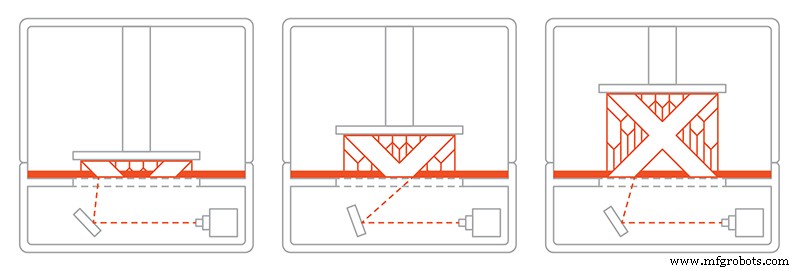
Another of its advantages, derived in part from this high precision, is that it achieves a superior surface finish to that obtained in DLP and LED-LCDs as it does not present the staircase effect that can be seen in the latter.
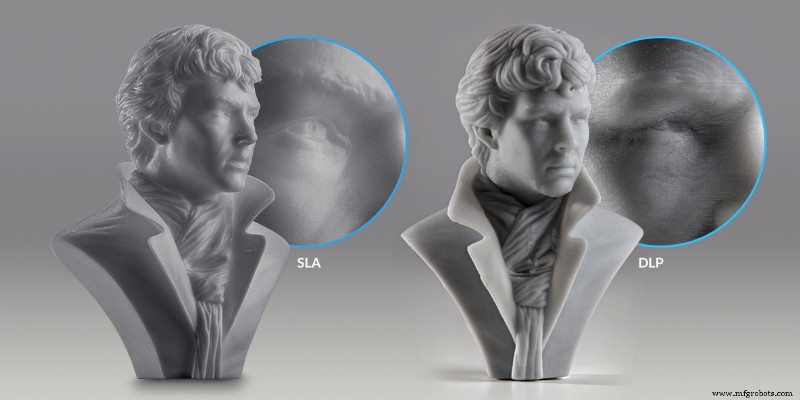
However, not everything is an advantage, as this is the slowest resin printing technology. For each layer it is necessary to sweep the entire surface of the part with the laser, which is a slow process, which increases the more parts we position in the construction space. In addition, it is necessary to keep the sweeping speeds within a specific range, as very high speeds would result in a loss of precision, the main strength of this technology.
This is the technology used by the renowned Formlabs printers , the benchmark brand for resin printing. Printers such as Form 3 or Form 3B use this technology in conjunction with high precision galvanometers to offer the highest quality standards in critical sectors such as high jewellery, dentistry or medicine.
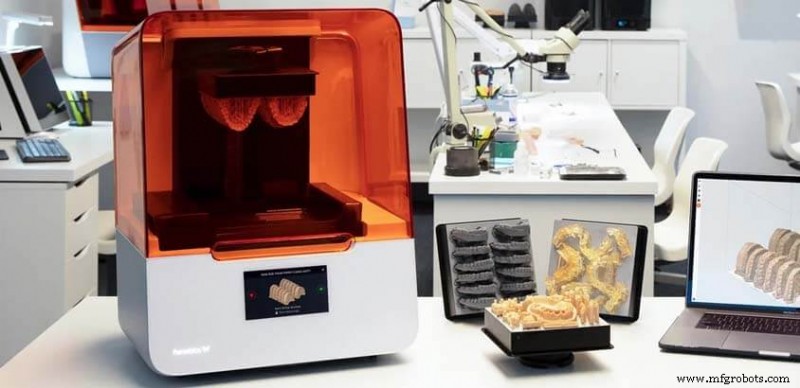 Image 4:Form 3B printer. Font:Formlabs.com
Image 4:Form 3B printer. Font:Formlabs.comDLP 3D printing technology was developed with the aim of reducing 3D resin printing times . Instead of sweeping the surface of the part with a laser, the entire layer is projected simultaneously using a light source, a device consisting of a moving micro-mirror array known as a DMD (Digital Micromirror Device) and a set of lenses responsible for projecting the image onto the resin.
This technology was a revolution , since each layer is formed in a few seconds and the printing time is independent of the number of pieces placed on the base, only of the height of these.
Its main disadvantage is that the printing resolution is determined by the density of micro-mirrors that form the DMD and the projected surface. For the same DMD system, a larger printing surface will always result in a proportional decrease in resolution, which is not the case with SLA systems, where the resolution is determined by the diameter of the laser beam and is independent of the printing surface.
In addition, the use of projection lenses can cause distortions in areas far from the centre , which are greater the larger the construction size. It is possible to correct these distortions by using more complex optical systems, however, they often make the device very expensive and therefore not very popular.
The surface quality of the pieces is usually slightly lower than those produced by SLA, and in many cases the staircase effect appears.

Although printing times were critically shortened, this technology did not displace SLA technology. Today, it is a technology that has fallen into disuse, displaced mainly by the appearance of LED-LCD technology.
It is the latest technology to reach the market and has experienced significant growth in recent years. It was developed as an evolution of DLP technology , and today has virtually replaced it.
Operation is similar to DLP technology, however, instead of reflecting light using a digital micromirror device (DMD), it uses an LCD device in which each pixel acts as a small window that blocks or lets light through.

Image 6:SLA vs DLP vs MSLA. Source:theorthocosmos.com
LCD devices are the same as those used in mobile screens or TV or computer panels, so the cost is much lower than that of DMD devices. In addition, they are available in sizes from 3" to 80", so the projection is direct and perpendicular to the base over the entire surface. This avoids the use of expensive and complex projection lens systems and the distortions they cause in DLP produced parts.
Among its main advantages are its high printing speed and low cost . In addition, it outperforms DLP technology in two key ways. As noted above, perpendicular projection prevents distortion from the oblique projection provided by lenses in DLP systems. Secondly, LCD devices not only block or allow light to pass through, but can also filter it by varying the light intensity independently at each pixel. This makes it possible to use anti-aliasing processes that reduce the staircase effect and allow for surface qualities very close to those obtained by SLA
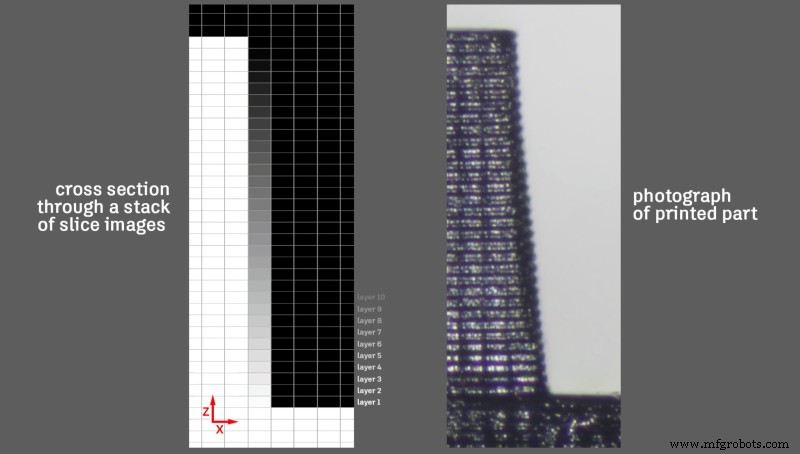
Image 7:Sub-pixel or anti-aliasing sampling to avoid staircase effect Source:hackaday.com
All of this has meant that its growth in recent years has not only displaced DLP technology but is beginning to replace SLA technology in industries such as dentistry, where SLA technology is a standard.
One of the main drawbacks is the high level of heating produced by the LED matrixes used , which means that effective cooling systems must be implemented to prevent the resin from heating up in long prints.
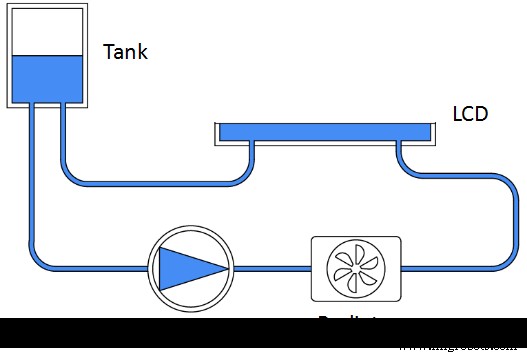
Image 8:Liquid cooling system of a Uniz printer. Source:Uniz.com
It is the technology present in all low-cost resin 3D printers and also the latest professional models such as the Uniz Slash.
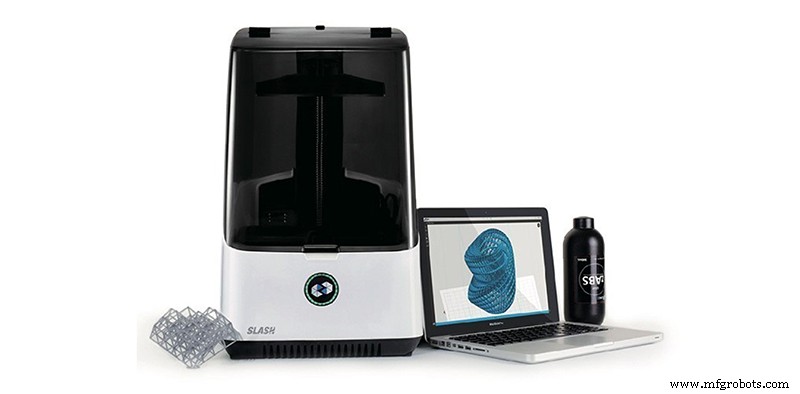
Image 9:Uniz Slash Plus printer. Source:Uniz.com
Today the dilemma could be reduced to two technologies:SLA or LED-LCD.
Despite the growth of LED-LCD technology, SLA technology is still the majority in professional environments. There are two reasons for this, firstly the high quality and accuracy achieved by SLA with printers such as Formlabs is difficult to match. On the other hand, new technologies need a transition period to make room in companies due to the need to amortise current equipment and the distrust of new systems with low implementation in their sector.
However, the new professional LED-LCD printers, such as the Uniz, can provide an important competitive advantage by allowing small series to be produced with a quality similar to SLA and in a fraction of the time. For example, in the production of models for lost-wax moulding, which is widely used in some branches of the jewellery industry and which can lead to significant savings, not only in time and resources, but also in costs.
The decision between one or the other must be based on the user's needs between precision and production capacity. In many cases they should be thought of not as rival technologies, but as complementary, having a team dedicated to the production of small series and another for more delicate and precise works.
3D 프린팅
3D 레진 프린팅은 모든 유형의 사용자가 사용할 수 있을 때까지 3D FDM 프린팅과 동일한 방식으로 발전했습니다. 3D 레진 프린터 사용을 통한 이러한 새로운 움직임은 광범위한 레진 개발로 이어졌습니다. 매우 다양한 특성과 용도를 가지고 있습니다. 이 기사에서는 기존 수지의 유형 및 용도를 설명하고 명확히 하려고 합니다. 3D 수지 프린터용(SLA, DLP, LED/LCD, LFS 등). 수지의 종류 대부분의 사용자는 FDM 기술 내의 재료 유형에 대해 잘 알고 있지만 3D 레진 프린팅을 시작할 때 일반적으로 레진 유형에 대한
광경화성 수지의 3D 프린팅은 최근 몇 년 동안 FFF에 이어 두 번째로 인기 있는 3D 프린팅 기술로 자리를 잡아가고 있습니다. , 전문가 및 제작자 환경 모두에서. 이러한 붐은 두 가지 중요한 요인의 결과였습니다. . 한편으로는 수지 3D 프린터의 저렴한 비용 새로운 기술의 출현으로 인해 레진 프린터는 FFF와 동일한 가격대에 놓였습니다. 한편, 신소재의 등장 치과용, 가요성 및 엔지니어링 레진과 같은 기술 덕분에 이전에는 FDM 또는 SLS를 통해서만 실행 가능했던 레진 부품을 생산할 수 있게 되었습니다. 치과나 보석류 등